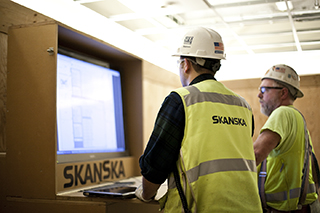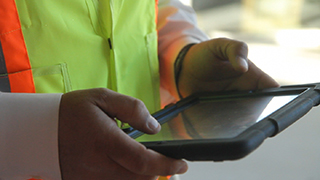|
Subscribe / Renew |
|
|
Contact Us |
|
| ► Subscribe to our Free Weekly Newsletter | |
| home | Welcome, sign in or click here to subscribe. | login |
Construction
| |
 |
May 2, 2013
Technology moves construction projects off the paper trail
Skanska USA

Hill
|
The construction industry is changing at a pace rarely seen and the Puget Sound region has a front-row seat. Consider the Bertschi School science classroom, which recently received certification as the state’s first Living Building after a year of performance monitoring.
Skanska USA worked with the Restorative Design Collective on the project to develop new ways to source materials to meet the Living Building Challenge’s red list requirements. One of the greatest challenges in this effort was finding local manufacturers and vendors that are transparent about the chemical makeup of products.
Looking forward, clients seeking a more sustainable design will have an easier time identifying ways to do so like never before.
On the Stone34 project, aiming to meet Seattle’s Deep Green Pilot Program requirement, that knowledge will be put to work again.
Even those changes, though, cannot keep pace with the way technology is changing construction. Right now, on the Stone34 project site — and many others throughout the Puget Sound region — technology is benefiting contractors and delivering value to clients in ways that weren’t possible even a few years ago.
New tools are helping contractors build projects more efficiently, helping shorten schedules — which could mean bottom-line savings all around — and helping clients get their facilities into operation faster.
There’s an app for that
Smartphones and tablets have become staples on job sites. Technology for technology’s sake, however, doesn’t change anything. Several years ago, Skanska looked at company processes and asked, “What can we do more effectively now that we have these tools?”
The results are a suite of proprietary apps that revolutionized best practices.
In active hospitals, for instance, Skanska monitors key environmental conditions in real time through hand-held devices. The Leak Prevention App, now standard on Skanska job sites, provides a visual record of quality inspections of a building’s interior.
In the past, a significant portion of warranty and punch-list work came from repairs to the exterior skin. From clients’ standpoint, this work was nothing less than a hassle. The projects contractors build aren’t just facilities for clients; they are key parts of their business plans. Downtime for warranty and punch list work can seriously affect a client’s business.
The Leak Prevention App unifies everyone on site with one set of checkpoints for a building’s exterior envelope. Instead of having to go through the construction documents — and the work of making sure each set of plans is updated in a timely manner — construction teams can ensure that quality is built in. The app has significantly reduced inspection time and is expected to reduce rework and cut product supply warranty callbacks in half.
Digital resource stations
The idea of putting together a common set of drawings has led to an entirely new way to interact with plans. Find any veteran project manager and ask about days spent taking RFIs and marking up sets of plans all over a job site. You’ll probably get a few eye rolls and good stories — almost all of them based off the inefficiency of the process.
Construction drawings haven’t changed that much in generations of construction.
The Skanska standard seeks to maintain electronic construction drawings, RFIs, subcontractor shop drawings and coordinated models for use out on job sites. Whether LCD monitors are mounted in the job trailer or mobile resource stations are installed in the field, field crews can access the most up-to-date documents within seconds. No long walks back to the trailer. No wondering if the plans and their RFI markups are up to date.
That kind of system gives all workers peace of mind. They not only work more efficiently, but confidently, knowing the information they’re basing their work on is correct.
Paperless job site
The result of combining these efforts has made the paperless job site a reality. This is especially true when looking at other methods to streamline job-site processes. Daily superintendent reports, for example, are now handled online. Instead of the time-consuming task the old paper system required, reports are now efficiently completed and distributed. This frees up more time to be in the field and focused on construction.
Finding ways to use electronic forms and record keeping only enhances the benefits. For instance, environmental savings on project sites can be tracked by noting the reduction in paper. Ultimately, the true winner is the client, who can feel good about the construction team using the most efficient processes possible and know their project will be delivered and operational ahead of a typical project.
Even better for the client: There’s very little added cost to deploy the types of technology that enable this increased efficiency. The construction industry must continue to seek opportunities to save clients time and money.
For Skanska, the opportunity fell, literally, into our hands.
Tony Hill is a senior project manager at Skanska USA in Seattle.
Other Stories:
- Safety's role in the ‘new normal’ of construction
- Health Care
- Commercial Construction
- Survey: Andersen Construction
- Demolition
- Specialty Construction (merit award)
- Survey: S.D. Deacon
- Survey: Lease Crutcher Lewis
- Survey: Skanska USA
- Survey: Express Construction Co.
- Survey: PCL Construction Services
- Electrical & Communications
- Mechanical Construction
- Mixed-Use Construction
- ‘Big Room’ streamlines collaboration, communication
- Going modular? Think of the factory as a big subcontractor
- Sharp equipment managers use decision points
- Sick leave, pot laws leave employers feeling queasy
- Making sense of construction cost audits
- Is your insurance broker a claims advocate?
- Avoid the pitfalls of transition planning
- Eagle of Excellence Award • Tenant Improvement/Renovation
- Eagle of Merit Award • Specialty Construction
- Institutional
- Survey: Rider Levett Bucknall




